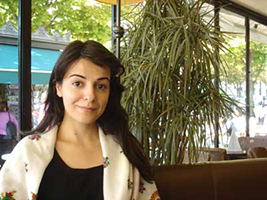
LIDA SHERAFATMAND
MALTA
Lida was born in Iran (the old Persia), and experienced a childhood of war time under the newly formed regime of 1979 revolution. Her birth city, Khorramshahr got wiped out completely in the bombardments as it was the first city to be attacked by Iraq marking the start of the Iran-Iraq war of the 1980's. In the meantime members of her relatives were executed by the government due to their contest towards the new regime. At the age of 15 Lida discovered the Universal Declaration of Human Rights through Amnesty International and this declaration for her seemed an opening door to a more humane world where people can be respected regardless their nationality or culture. At that time together with her family they had left Iran and settled in Malta. Although Lida's passion for drawing started at the tender age of 3, but she made her firm decision to somehow dedicate her talent towards the promotion of peace and friendship among people at the age of 19 when she enrolled at an art school in Malta. Focused on human rights and peace, Lida started her art path by creating paintings with messages. She connected her works to grassroots and international organisations working in the fields of peace and human rights. Her works have traveled to 17 countries so far and been published by major bodies such as Amnesty International, UN, UNESCO and others. While based in Malta, in 2004, she wrote "Humanitarian Art Manifesto", designed to create a synergy among artists who share the same line of commitment in their art creations. Her manifesto got translated into 7 languages and signed by artistsfrom 22 countries
In 2006 she moved to Paris to face the challenges of the art world and deepen her path as an artist. There her painting evolved in style and was presented at several galleries, salons and auctions. Her design works were presented at important international salons in Paris and got to the winning table of France's Championships of the Art of Table Wear. In 2011 she headed back to Malta, and changed her focus from human rights concepts onto the internal states of the human spirit. This shift was the result of her years of effort trying to promote human rights which tend to meet many challenges on a cultural and political level. By this time she was enrolled in a Masters by research in international relations and upon finishing her masters, she joint an international think-tank NGO called Global Harmony Association. This association provided her a new platform to discuss her ideas both as an artist and as an academic researcher. In 2012 her paintings took off with a new force, whereby she no longer conveyed messages on human rights, but she tried to connect directly to the soul of individuals...letting the paintings be like a mirror for the viewer to see his/her own reflections inside.
The new 'period' of Lida's visual style which uses movements and symbolism of flowers, is yet another start for for her towards further research, further growth, and further development. Enrolled in the journey of life, she hopes to share her findings with others, as well as contribute with her paintings towards the environment where she believes the paintings become part of our physical, emotional and intellectual reality
|


